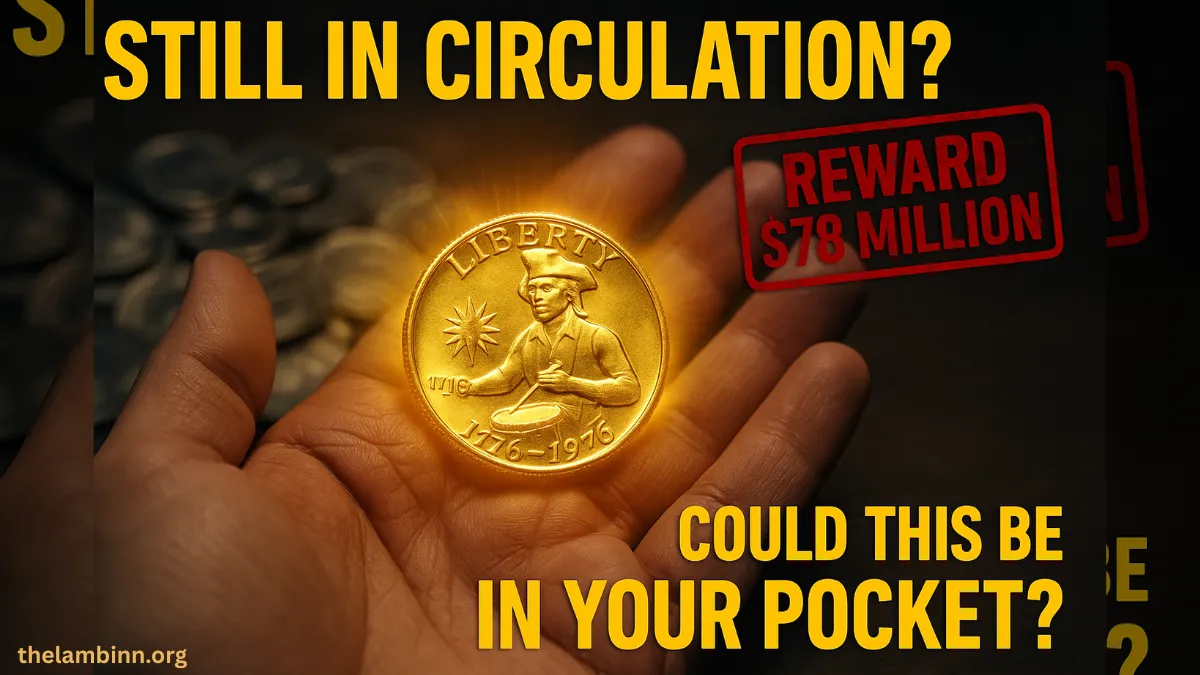The American Bicentennial Quarter, produced in 1975 and 1976 to celebrate 200 years of U.S. independence, remains a standout in American coinage.
Though nearly 1.7 billion were minted and most are worth just 25 cents, a select few rare versions have reached an astonishing total valuation of $78 million. Some of these unique quarters are believed to still circulate unnoticed, offering a once-in-a-lifetime opportunity to anyone who stumbles upon them.
The Unique Colonial Drummer Design
Designed by Jack L. Ahr, the reverse of the Bicentennial Quarter features a colonial drummer and a torch surrounded by thirteen stars, replacing the usual eagle motif.
The obverse side retains George Washington’s image but includes the dual date “1776-1976.” All Bicentennial Quarters, whether struck in 1975 or 1976, feature this dual date.
The Legendary $45 Million Silver-Clad Mule
Topping the rarity chart is the “Silver-Clad Mule,” valued at $45 million. This anomaly combines a copper-nickel clad obverse with a 40% silver reverse—an error believed to have occurred when a silver-clad planchet partially fused with a standard one before striking.
This blend of compositions is normally impossible, making the coin one of a kind. The best-known example, rated MS-67 by PCGS, is held privately and reportedly sold for over $25 million.
The $18.5 Million Double-Struck Drummer
Another standout rarity is the “Double-Struck Drummer,” a quarter that underwent two strikes with a 50% rotation between them. This created overlapping images of the drummer and torch, producing a visually stunning error.
Only three have been confirmed, with the highest-graded piece fetching $18.5 million in 2022.
The $8.2 Million No-S Proof Quarter
Proof quarters from the San Francisco Mint typically display an “S” mintmark. However, a few were mistakenly struck without it. These “No-S” proof coins are exceptionally rare due to the high quality control of proof minting. Only five are known, with the best-rated version recently valued at $8.2 million.
The $3.7 Million Bronze Off-Metal Error
Occasionally, quarter designs were struck on bronze planchets meant for pennies, resulting in copper-colored quarters weighing only 3.1 grams. These off-metal strikes are visually distinct and have reached values as high as $3.7 million at auction. Seven examples have been verified.
The $1.8 Million Reverse Die Cap Error
A die cap error occurs when a coin gets stuck on a die and continues to strike other coins. This creates a distorted image, often with stretched features. The most dramatic Bicentennial Quarter with this error expanded about 5mm beyond normal size and sold for $1.8 million in 2021. Despite the distortion, the drummer image remained visible, enhancing its appeal.
The $750,000 Dual Design Rarity
During the transition back to the standard eagle design in 1977, some quarters were struck using the Bicentennial obverse paired with the new reverse. Only eight of these mismatched “Dual Design” coins are known. Pristine examples have been valued up to $750,000 due to their unique historical context.
The $35,000 Broadstruck Quarter
Broadstruck errors occur when the collar die fails to engage properly, causing the coin to expand beyond normal limits. Bicentennial Quarters with this error display a spread-out drummer design and no reeded edge. One of the most pronounced examples sold for $35,000 in 2024. Many may still be in circulation but often go unrecognized.
How to Identify Rare Bicentennial Quarters
Collectors are encouraged to inspect their quarters closely. Unusual color, weight, or design features may hint at a valuable variant.
- Standard weight: 5.67 grams. Any significant deviation may indicate a rare strike.
- Look for color: Copper-colored coins may be off-metal errors.
- Check for doubling: Use magnification to see if design elements like the drummer or torch are duplicated.
- Mintmark check: Proof coins without an “S” mintmark are likely rare.
- Composition clues: Examine the edge for hints of silver or unusual layering.
- Design mismatch: Watch for the Bicentennial date with a non-drummer reverse.
Authenticating and Preserving Your Find
If you think you’ve found a rare quarter, avoid cleaning it. Place it in a non-PVC holder, record its weight, take clear photos of both sides, and send it to a trusted grading service like PCGS or NGC. Even worn examples of rare variants can command high prices.
In recent years, new discoveries have proven that rare Bicentennial Quarters are still turning up. In 2021, a Silver-Clad Mule was found in a roll of quarters from a Missouri bank and later sold for over $20 million. This highlights that everyday finds can still yield extraordinary rewards for careful collectors.
FAQs
How can I tell if my Bicentennial Quarter is valuable?
Check for errors like missing mintmarks, odd colors, weight differences, or design mismatches on either side of the coin.
What is the rarest Bicentennial Quarter?
The Silver-Clad Mule, valued at $45 million, is the rarest and most valuable Bicentennial Quarter known to exist.
Can rare Bicentennial Quarters still be found in circulation?
Yes, several known rare variants are believed to still exist in circulation and may turn up in pocket change or coin rolls.
What should I do if I find a suspicious Bicentennial Quarter?
Don’t clean it. Store it safely, weigh it, take clear photos, and submit it for evaluation by PCGS or NGC for authentication.
Walter is a dedicated finance blog writer known for his insightful analysis and practical money advice. With a strong background in financial planning and market research, he simplifies topics like saving, investing, and retirement for readers of all levels. Walter’s goal is to help individuals take control of their finances and build a secure financial future through informed decisions.
